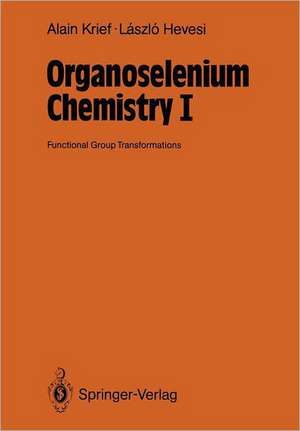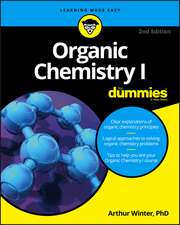Organoselenium Chemistry I: Functional Group Transformations
Autor Alain Krief, Laszlo Hevesien Limba Engleză Paperback – 6 dec 2011
Preț: 386.81 lei
Nou
Puncte Express: 580
Preț estimativ în valută:
74.03€ • 76.70$ • 61.78£
74.03€ • 76.70$ • 61.78£
Carte tipărită la comandă
Livrare economică 21 martie-04 aprilie
Preluare comenzi: 021 569.72.76
Specificații
ISBN-13: 9783642732430
ISBN-10: 3642732437
Pagini: 236
Ilustrații: XI, 221 p.
Dimensiuni: 170 x 244 x 12 mm
Greutate: 0.39 kg
Ediția:Softcover reprint of the original 1st ed. 1988
Editura: Springer Berlin, Heidelberg
Colecția Springer
Locul publicării:Berlin, Heidelberg, Germany
ISBN-10: 3642732437
Pagini: 236
Ilustrații: XI, 221 p.
Dimensiuni: 170 x 244 x 12 mm
Greutate: 0.39 kg
Ediția:Softcover reprint of the original 1st ed. 1988
Editura: Springer Berlin, Heidelberg
Colecția Springer
Locul publicării:Berlin, Heidelberg, Germany
Public țintă
ResearchCuprins
1. Introduction.- 1.1 Historical Review.- 1.2 Abundance and Distribution of Selenium.- 1.3 Selenium in Plants.- 1.4 Selenium Toxicity in Animals.- 1.5 Enzymic Role of Selenium.- 1.6 Ecological Aspects of Selenium in Human Health.- 1.7 Extraction of Selenium.- 1.8 Industrial Uses of Selenium.- 1.9 Selenium: Structure, Physical and Chemical Properties.- 2. Reactions Involving Hydrogen Selenide, Selenols and Related Compounds.- 2.1 Reactions Involving the Nucleophilicity of Hydrogen Selenide, Selenols and Related Compounds.- 2.2 Reduction Reactions Involving Hydrogen Selenide, Selenols, Selenocyanates, Triphenylphosphine Selenide and Related Compounds.- 2.3 Use of Copper (I) Benzeneselenolate.- 2.4 Reduction of Dienes to Olefins With Dichloro Bis (Diphenyl Selenide) Platinum (II).- 3. Reactions Involving Metallic or Amorphous Selenium with Organic Molecules.- 3.1 Transformation of (Z) Alkenes to Their (E) Isomers.- 3.2 Oxidation of Cyclic and Poly cyclic Hydrocarbons and Heterocycles to Aromatic Compounds Using Elemental Selenium.- 3.3 Oxido-reduction Reactions of Hydrocarbons.- 3.4 Reactions Involving Carbon Monoxide and Catalytic Amounts of Selenium.- 4. Reactions Involving Selenoxides and Related Derivatives.- 4.1 Reactions Involving Selenoxides.- 4.2 Oxidation of Alcohols to Carbonyl Compounds with Dimethylselenide/N-chlorosuccinimide.- 4.3 Oxidative Conversion of sec-Benzylamines to Imines and Tertiary Benzylamines to Iminium Salts by Diphenylselenium Bis(trifluoroacetate).- 5. Reactions Involving Selenenyl Halides and Related Compounds.- 5.1 Allylic Halogenation of Olefins.- 5.2 Ring Expansion of 1,3-Dithiolans and 1,3-Dithians.- 5.3 Oxidation of Alcohols to Carbonyl Compounds.- 5.4 Synthesis of Oligonucleotides and Nucleoside Phosphoramidates.- 6. Reactions Involving Benzeneseleninic Anhydride (BSA) and Related Reagents.- 6.1 Oxidation of Phenols, Pyrocatechols and Hydroquinones.- 6.2 Dehydrogenation of Ketones to Enones and Dienones.- 6.3 Dehydrogenation of Lactones and Lactams to ?, ?-Unsaturated Compounds.- 6.4 Oxidation of Alcohols to Carbonyl Compounds or to Enones and Dienones.- 6.5 Oxidative Conversion of Thiols to Disulfides, Sulfides to Sulfoxides and of Phosphines to Phosphinoxides.- 6.6 Oxidation of Amines.- 6.7 Oxidation of Hydrazines.- 6.8 Oxidation of Hydroxylamines.- 6.9 Oxidation of the Alkyl Chain of Aromatic and Heteroaromatic Compounds.- 6.10 Regeneration of Carbonyl Compounds.- 6.11 Synthesis of ?-Selenocarbonyl Compounds from BSA and.- 6.12 Synthesis of Allyl Alcohols from Allyl Silanes.- 7. Reactions Involving Benzeneseleninyl Halides.- 7.1 Oxidation of Aldoximes to Nitriles.- 7.2 Oxidation of Amines.- 7.3 Dehydrogenation of Carbonyl Compounds to Enones.- 8. Reactions Involving Perseleninic Acids.- 8.1 Oxidation of Olefins to Epoxides.- 8.2 Baeyer-Villiger Type Oxidation of Ketones to Esters and Lactones.- 8.3 Oxidation of Selenides to Selenoxides and Selenones and of Sulfides to Sulfoxides or Sulfones.- 9. Selenium Dioxide Oxidations.- 9.1 Reactivity of SeO2 with Alkenes.- 9.2 Reactivity of SeO2 Towards Acetylenic Hydrocarbons.- 9.3 Reactivity of SeO2 with Carbonyl Compounds.- 9.4 Oxidation of the Alkyl Chain of Aromatic and Heteroaromatic Compounds.- 9.5 Oxidation of Benzylic and Allylic Alcohols.- 9.6 Oxidation of Hydrazones, Imines, Oximes and Semicarbazones.- 9.7 Conversion of Thio- and Selenocarbonyl Compounds to Carbonyl Compounds.- 9.8 Reactions of Nitroalkanes: Synthesis of N-hydroxy Carboxamides and Nitriles.- 9.9 Synthesis of Olefins from Phosphorus Ylides and Diazoalkanes.- 9.10 Reaction ofSeO2 with Phosphines, Arsines, Stibines and Related Compounds.- 9.11 Reaction with Hydrazines.- 9.12 Reaction with Organometallics.- 10. Reactions of Imidoselenium Compounds.- 10.1 With Alkenes and Alkynes: Synthesis of Allylic and Propargylic Amines.- 10.2 With Dienes: Synthesis of Cis Diaminoalkanes.- 11. Reactions Involving Selenium Oxychloride and Selenium Tetrahalides.- 11.1 Reactivity of Selenium Oxychloride.- 11.2 Reactivity of Selenium Tetrafluoride.- 11.3 Reactivity of Selenium Tetrachloride.- References.










